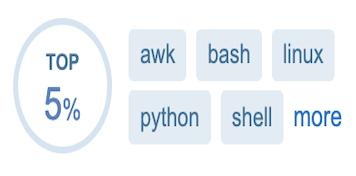awk
Power for your command line
Created by Juan Diego Godoy Robles / @klashxx
Video talk
whoami
Sysadmin & Dev • First program CPC 6128

awk
What??
"AWK is a programming language designed for text processing and typically used as a data extraction and reporting tool. It is a standard feature of most Unix-like operating systems."
— Wikipedia
What for??
"for purposes of extracting or transforming text, such as producing formatted reports. The language extensively uses the string datatype, associative arrays (that is, arrays indexed by key strings), and regular expressions."
— Wikipedia
AWKward name ...
"its name is derived from the surnames of its authors – Alfred Aho, Peter Weinberger, and Brian Kernighan."
So awk
Searchs for lines that contain certain patterns
$ awk '/dolor/' lorem_ipsum.dat
Lorem ipsum dolor sit amet, consectetur adipiscing elit.
Data Driven
describe the data you want to work with and then what action to do when you find it.
$ awk '/dolor/{print $1}' lorem_ipsum.dat
Lorem
BEGIN and END
startup and cleanup actions for awk programs.
BEGIN{
// initialize variables
}
{
/pattern/ { action }
}
END{
// cleanup
}
Executed once only
BEGIN before the first input record is read, END after all the input is consumed.
Run it
Short way
awk 'program' input-file1 input-file2
cmd | awk 'program'
Long one
awk -f program-file input-file1 input-file2
cmd | awk -f program-file
#!/bin/awk -f
BEGIN { print "hello world!!" }
RECORDS and FIELDS
Records
- Records are separated by a character called the Record Separator RS.
- By default, the record separator is the unix newline character \n. This is why records are single lines.
- Additionally awk has ORS Output Record Separator to control the way records are presented to the stdout
$ awk 'BEGIN{RS=" *, *";ORS="<<<\n"}{print $0}' lorem_ipsum.dat
Lorem ipsum dolor sit amet<<<
consectetur adipiscing elit.
Maecenas pellentesque erat vel tortor consectetur condimentum.
Nunc enim orci<<<
euismod id nisi eget<<<
interdum cursus ex.
Curabitur a dapibus tellus.
Lorem ipsum dolor sit amet<<<
consectetur adipiscing elit.
Aliquam interdum mauris volutpat nisl placerat<<<
et facilisis neque ultrices.
<<<
NR and FNR
- NR: number of input records awk has processed since the beginning of the program’s execution.
- FNR: current record number in the current file, awk resets FNR to zero each time it starts a new input file.
$ cat n1.dat
one
two
$ cat n2.dat
three
four
$ awk '{print NR,FNR,$0}' n1.dat n2.dat
1 1 one
2 2 two
3 1 three
4 2 four
RECORDS and FIELDS
Fields
- By default, fields are separated by whitespace (any string of one or more spaces, TABs, or newlines), like words in a line.
- To refer to a field in an awk program, you use a dollar $ sign followed by the number of the field you want.
- $0 represents the whole input record.
- NF is a predefined variable it's value is the number of fields in the current record. So, $NF will be always the last field of the record.
-
$ cat lorem.dat Lorem ipsum dolor sit amet, consectetur adipiscing elit. Maecenas pellentesque erat vel tortor consectetur condimentum. Nunc enim orci, euismod id nisi eget, interdum cursus ex. Curabitur a dapibus tellus. Lorem ipsum dolor sit amet, consectetur adipiscing elit. Aliquam mauris volutpat nisl placerat, et facilisis neque ultrices. -
$ awk '{print $1,$NF,NF}' lorem.dat Lorem elit. 8 Maecenas condimentum. 7 Nunc ex. 10 Curabitur tellus. 4 Lorem elit. 8 Aliquam ultrices. 9
$ cat group
nobody:*:-2:
nogroup:*:-1:
wheel:*:0:root
daemon:*:1:root
kmem:*:2:root
sys:*:3:root
tty:*:4:root
$ awk '!/^(_|#)/&&$1=$1' FS=":" OFS="<->" group
nobody<->*<->-2<->
nogroup<->*<->-1<->
wheel<->*<->0<->root
daemon<->*<->1<->root
kmem<->*<->2<->root
sys<->*<->3<->root
tty<->*<->4<->root
Working with arrays
awk 'BEGIN{
a[4]="four"
a[1]="one"
a[3]="three"
a[2]="two"
a[0]="zero"
exit
}
END{for (idx in a){
print idx, a[idx]
}
}'
4 four
0 zero
1 one
2 two
3 three
Build-in functions
awk 'gsub(/\./, ",")' lorem.dat
Lorem ipsum dolor sit amet, consectetur adipiscing elit,
Maecenas pellentesque erat vel tortor consectetur condimentum,
Nunc enim orci, euismod id nisi eget, interdum cursus ex,
Curabitur a dapibus tellus,
Lorem ipsum dolor sit amet, consectetur adipiscing elit,
Aliquam interdum mauris volutpat nisl placerat, et facilisis
$ awk 'BEGIN{t="hello-world";print index(t, "-")}'
6
$ awk 'BEGIN{t="hello-world";print substr(t,index(t, "-")+1)}'
world
$ cat passwd
jd001:x:1032:666:Javier Diaz:/home/jd001:/bin/rbash
ag002:x:8050:668:Alejandro Gonzalez:/home/ag002:/bin/rbash
jp003:x:1000:666:Jose Perez:/home/jp003:/bin/bash
ms004:x:8051:668:Maria Saenz:/home/ms004:/bin/rbash
rc005:x:6550:668:Rosa Camacho:/home/rc005:/bin/rbash
$ awk 'n=split($0, a, ":"){print n, a[n]}' passwd
7 /bin/rbash
7 /bin/rbash
7 /bin/bash
7 /bin/rbash
7 /bin/rbash
Custom functions
awk 'function test(m){
return sprintf("This is a test func, parameter: %s", m)
}
BEGIN{print test("param")}'
This is a test func, parameter: param